hopcroft_titlepgs 5/8/06 12:43 PM Page 1
I N T R O D U C T I O N T O
Automata Theory,
Languages, and
Computation
3rd Edition
�
hopcroft_titlepgs 5/8/06 12:43 PM Page 2
I N T R O D U C T I O N T O
Automata Theory,
Languages, and
Computation
3rd Edition
J O H N E . H O P C R O F T
Cornell University
R A J E E V M O T W A N I
Stanford University
J E F F R E Y D . U L L M A N
Stanford University
�
Joe Vetere
Greg Tobin
Michael Hirsch
Matt Goldstein
Katherine Harutunian
Jeffrey Holcomb
Joyce Cosentino Wells
Marianne Groth
Bethany Tidd
Michelle Brown
Dana Lopreato
Publisher
Executive Editor
Acquisitions Editor
Project Editor
Associate Managing Editor
Cover Designer
Digital Assets Manager
Media Producer
Marketing Manager
Marketing Assistant
Senior Author Support/
Technology Specialist
Senior Manufacturing Buyer Carol Melville
Media Manufacturing Buyer Ginny Michaud
Many of the exercises that appear in this text use the stems of questions from
Gradiance Corporation, which retains the copyright to all such questions.
© Gradiance Corp., 2004–2006
Many of the designations used by manufacturers and sellers to distinguish their
products are claimed as trademarks. Where those designations appear in this book,
and Addison-Wesley was aware of a trademark claim, the designations have been
printed in initial caps or all caps.
Library of Congress Cataloging-in-Publication Data
Hopcroft, John E., 1939-
Introduction to automata theory, languages, and computation / by John E. Hopcroft,
Rajeev Motwani, Jeffrey D. Ullman. -- 3rd ed.
p. cm.
Includes bibliographical references and index.
ISBN 0-321-45536-3
1. Machine theory. 2. Formal languages. 3. Computational complexity. I.
Motwani, Rajeev. II. Ullman, Jeffrey D., 1942- III. Title.
QA267.H56 2006
511.3'5--dc22
2006014263
Copyright © 2007 Pearson Education, Inc. All rights reserved. No part of this
publication may be reproduced, stored in a retrieval system, or transmitted, in any
form or by any means, electronic, mechanical, photocopying, recording, or
otherwise, without the prior written permission of the publisher. Printed in the
United States of America. For information on obtaining permission for use of
material in this work, please submit a written request to Pearson Education, Inc.,
Rights and Contracts Department, 75 Arlington Street, Suite 300, Boston, MA
02116, fax your request to 617-848-7047, or e-mail at
http://www.pearsoned.com/legal/permissions.htm.
1 2 3 4 5 6 7 8 9 10—CW—10 09 08 07 06
�
Preface
In the preface from the � � predecessor to this book Hopcroft and Ullman
marveled at the fact that the subject of automata had exploded compared with
its state at the time they wrote their rst book in � � Truly the � � book
contained many topics not found in the earlier work and was about twice its
size If you compare this book with the � � book you will nd that like the
automobiles of the � ��s this book is larger on the outside but smaller on
the inside That sounds like a retrograde step but we are happy with the
changes for several reasons
First in � � automata and language theory was still an area of active
research A purpose of that book was to encourage mathematically inclined
students to make new contributions to the eld Today there is little direct
research in automata theory as opposed to its applications and thus little
motivation for us to retain the succinct highly mathematical tone of the � �
book
Second the role of automata and language theory has changed over the
past two decades In � � automata was largely a graduatelevel subject and
we imagined our reader was an advanced graduate student especially those
using the later chapters of the book Today the subject is a staple of the
undergraduate curriculum As such the content of the book must assume less
in the way of prerequisites from the student and therefore must provide more
of the background and details of arguments than did the earlier book
A third change in the environment is that Computer Science has grown to
an almost unimaginable degree in the past three decades While in � � it was
often a challenge to ll up a curriculum with material that we felt would survive
the next wave of technology today very many subdisciplines compete for the
limited amount of space in the undergraduate curriculum
Fourthly CS has become a more vocational subject and there is a severe
pragmatism among many of its students We continue to believe that aspects
of automata theory are essential tools in a variety of new disciplines and we
believe that the theoretical mindexpanding exercises embodied in the typical
automata course retain their value no matter how much the student prefers to
learn only the most immediately monetizable technology However to assure
a continued place for the subject on the menu of topics available to the com
puter science student we believe it is necessary to emphasize the applications
v
�
vi
PREFACE
along with the mathematics Thus we have replaced a number of the more
abstruse topics in the earlier book with examples of how the ideas are used
today While applications of automata and language theory to compilers are
now so well understood that they are normally covered in a compiler course
there are a variety of more recent uses including modelchecking algorithms
to verify protocols and documentdescription languages that are patterned on
contextfree grammars
A nal explanation for the simultaneous growth and shrinkage of the book
is that we were today able to take advantage of the TEX and LATEX typesetting
systems developed by Don Knuth and Les Lamport The latter especially
encourages the open style of typesetting that makes books larger but easier
to read We appreciate the eorts of both men
Use of the Book
This book is suitable for a quarter or semester course at the Junior level or
above At Stanford we have used the notes in CS��� the course in automata
and language theory It is a onequarter course which both Rajeev and Je have
taught Because of the limited time available Chapter �� is not covered and
some of the later material such as the more dicult polynomialtime reductions
in Section ��� are omitted as well The books Web site see below includes
notes and syllabi for several oerings of CS���
Some years ago we found that many graduate students came to Stanford
with a course in automata theory that did not include the theory of intractabil
ity As the Stanford faculty believes that these ideas are essential for every
computer scientist to know at more than the level of NPcomplete means it
takes too long there is another course CS���N that students may take to
cover only Chapters � and �� They actually participate in roughly the last
third of CS��� to fulll the CS���N requirement Even today we nd several
students each quarter availing themselves of this option Since it requires little
extra eort we recommend the approach
Prerequisites
To make best use of this book students should have taken previously a course
covering discrete mathematics eg graphs trees logic and proof techniques
We assume also that they have had several courses in programming and are
familiar with common data structures recursion and the role of major system
components such as compilers These prerequisites should be obtained in a
typical freshmansophomore CS program
�
PREFACE
Exercises
vii
The book contains extensive exercises with some for almost every section We
indicate harder exercises or parts of exercises with an exclamation point The
hardest exercises have a double exclamation point
Some of the exercises or parts are marked with a star For these exercises
we shall endeavor to maintain solutions accessible through the books Web page
These solutions are publicly available and should be used for selftesting Note
that in a few cases one exercise B asks for modication or adaptation of your
solution to another exercise A If certain parts of A have solutions then you
should expect the corresponding parts of B to have solutions as well
Gradiance OnLine Homeworks
A new feature of the third edition is that there is an accompanying set of online
homeworks using a technology developed by Gradiance Corp Instructors may
assign these homeworks to their class or students not enrolled in a class may
enroll in an omnibus class that allows them to do the homeworks as a tutorial
without an instructorcreated class Gradiance questions look like ordinary
questions but your solutions are sampled If you make an incorrect choice you
are given specic advice or feedback to help you correct your solution If your
instructor permits you are allowed to try again until you get a perfect score
A subscription to the Gradiance service is oered with all new copies of this
text sold in North America For more information visit the AddisonWesley
web site wwwawcomgradiance or send email to computingawcom
Support on the World Wide Web
The books home page is
httpwwwdbstanfordeduullmanialchtml
Here are solutions to starred exercises errata as we learn of them and backup
materials We hope to make available the notes for each oering of CS��� as
we teach it including homeworks solutions and exams
Acknowledgements
A handout on how to do proofs by Craig Silverstein inuenced some of the
material in Chapter � Comments and errata on drafts of the second edition
���� were received from Zoe Abrams George Candea Haowen Chen Byong
Gun Chun Jerey Shallit Bret Taylor Jason Townsend and Erik Uzureau
We also received many emails pointing out errata in the second edition of
this book and these were acknowledged online in the errata sheets for that
�
viii
PREFACE
edition However we would like to mention here the following people who
provided large numbers of signicant errata Zeki Bayram Sebastian Hick
KangRae Lee Christian Lemburg Nezam MahdaviAmiri Dave Maier A
P Marathe Mark Meuleman Mustafa SaitAmetov Alexey Sarytchev Jukka
Suomela Rod Topor PoLian Tsai Tom Whaley Aaron Windsor and Jacinth
HT Wu
The help of all these people is greatefully acknowledged Remaining errors
are ours of course
J E H
R M
J D U
Ithaca NY and Stanford CA
February ����
�
Table of Contents
� Automata The Methods and the Madness
�� Introduction to Formal Proof
�
�
�� Why Study Automata Theory
�
Introduction to Finite Automata
���
�
���
Structural Representations
�
��� Automata and Complexity
�
�
��� Deductive Proofs
��� Reduction to Denitions
�
��� Other Theorem Forms ��
��� Theorems That Appear Not to Be IfThen Statements ��
�� Additional Forms of Proof ��
��� Proving Equivalences About Sets ��
��� The Contrapositive ��
��� Proof by Contradiction ��
��� Counterexamples ��
�
���
Inductions on Integers �
��� More General Forms of Integer Inductions ��
���
��
��� Mutual Inductions ��
�� The Central Concepts of Automata Theory ��
��� Alphabets ��
Strings �
���
��� Languages ��
��� Problems
��
�� Summary of Chapter � ��
�� Gradiance Problems for Chapter � ��
�� References for Chapter � ��
�� Inductive Proofs
Structural Inductions
� Finite Automata
��
�� An Informal Picture of Finite Automata ��
��� The Ground Rules ��
�
��� The Protocol
ix
�

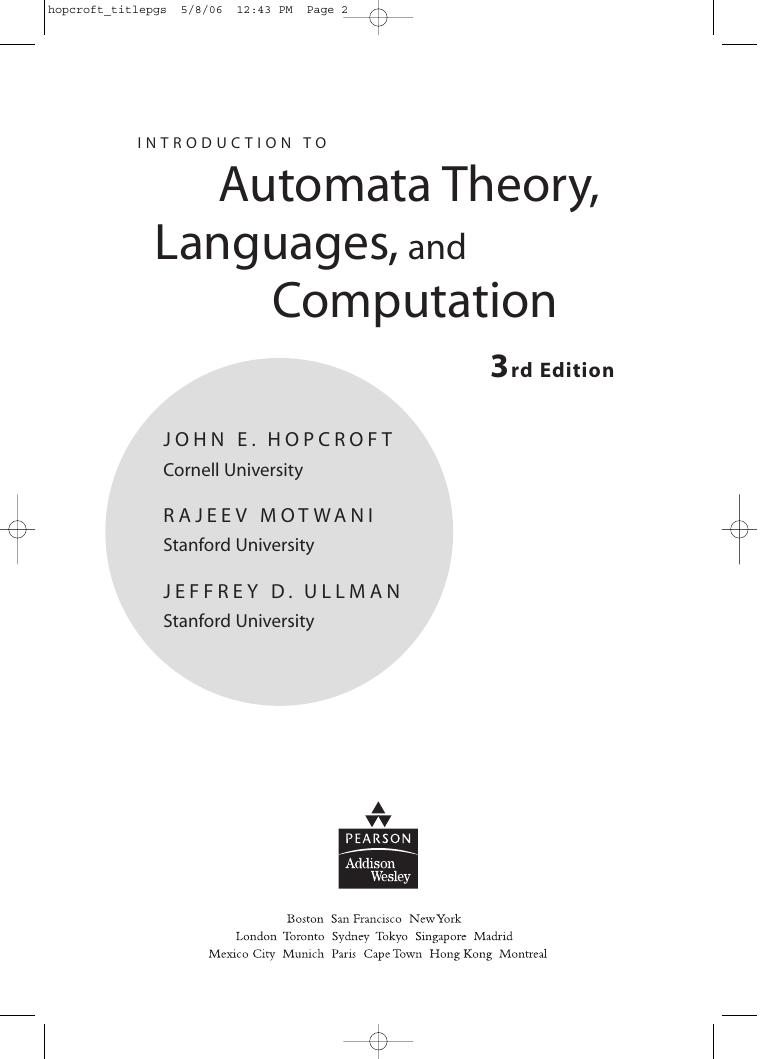
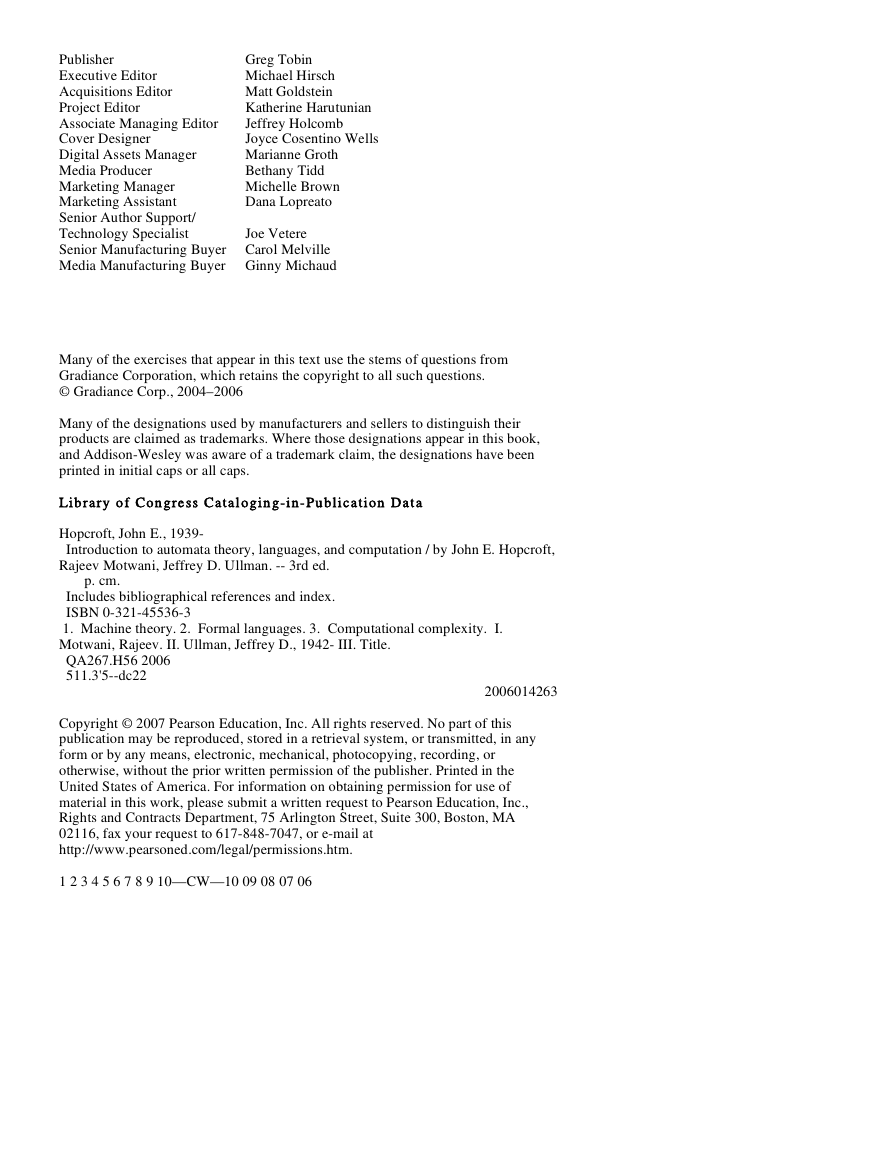
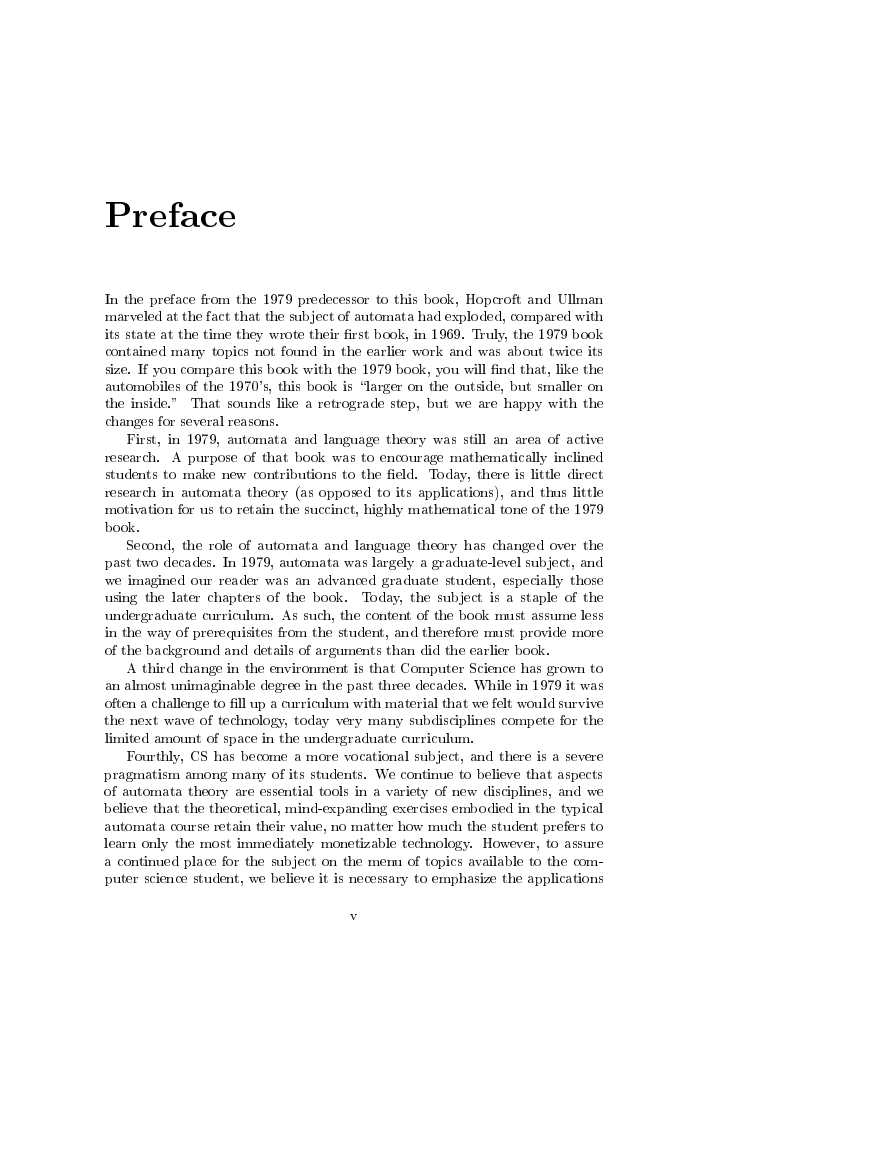

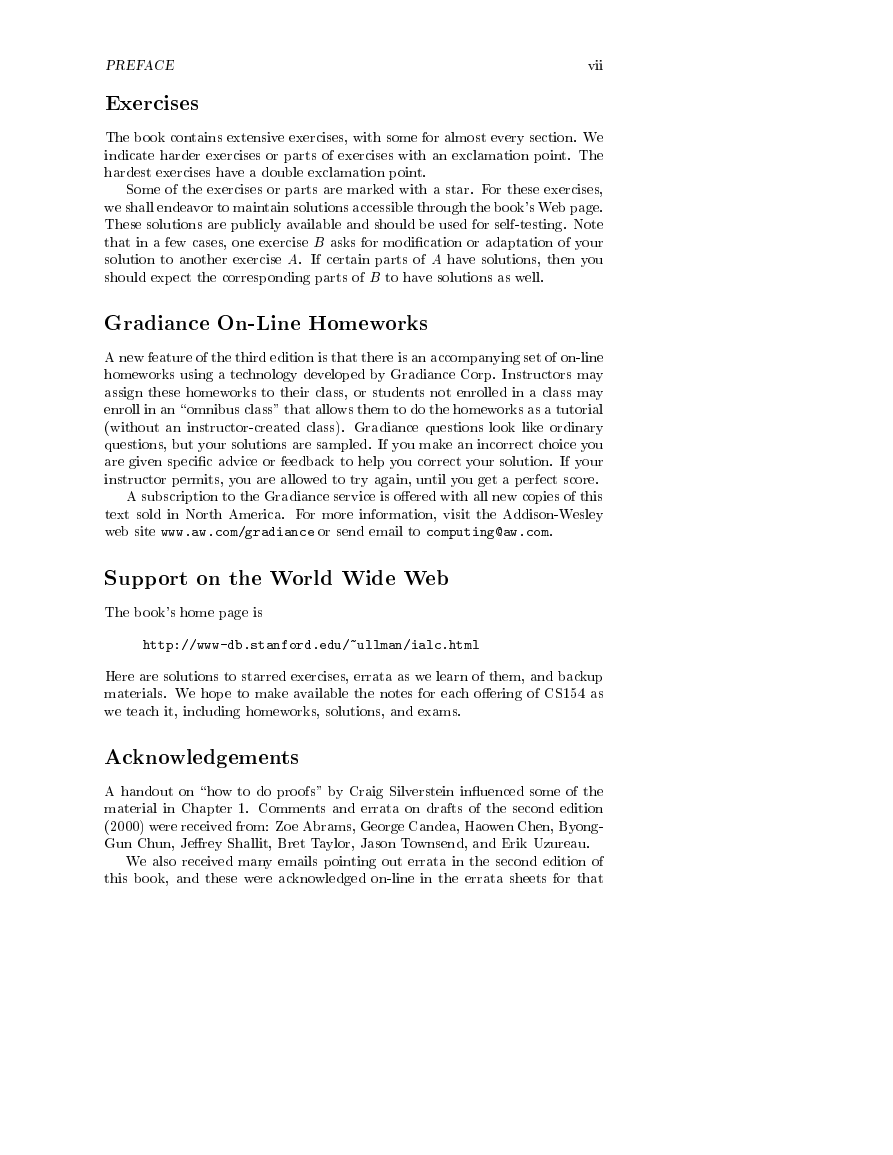

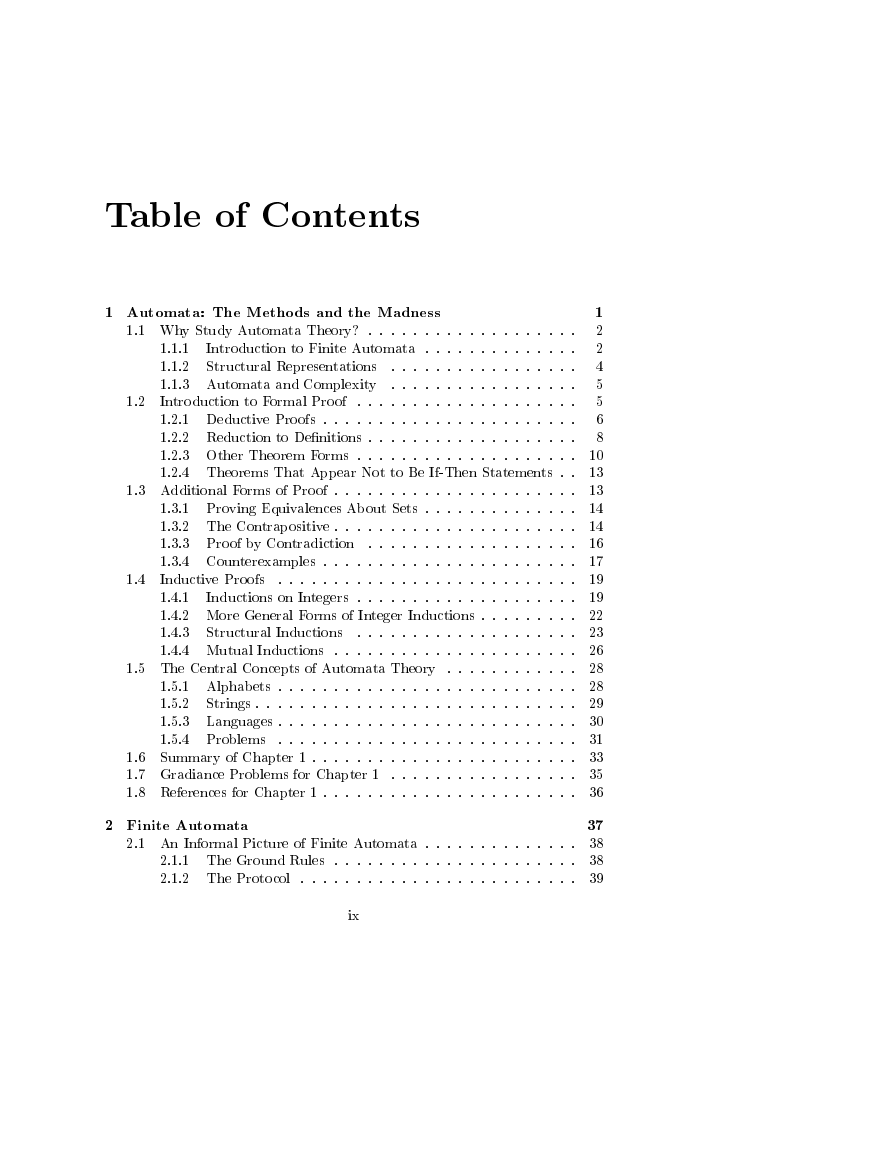








 2023年江西萍乡中考道德与法治真题及答案.doc
2023年江西萍乡中考道德与法治真题及答案.doc 2012年重庆南川中考生物真题及答案.doc
2012年重庆南川中考生物真题及答案.doc 2013年江西师范大学地理学综合及文艺理论基础考研真题.doc
2013年江西师范大学地理学综合及文艺理论基础考研真题.doc 2020年四川甘孜小升初语文真题及答案I卷.doc
2020年四川甘孜小升初语文真题及答案I卷.doc 2020年注册岩土工程师专业基础考试真题及答案.doc
2020年注册岩土工程师专业基础考试真题及答案.doc 2023-2024学年福建省厦门市九年级上学期数学月考试题及答案.doc
2023-2024学年福建省厦门市九年级上学期数学月考试题及答案.doc 2021-2022学年辽宁省沈阳市大东区九年级上学期语文期末试题及答案.doc
2021-2022学年辽宁省沈阳市大东区九年级上学期语文期末试题及答案.doc 2022-2023学年北京东城区初三第一学期物理期末试卷及答案.doc
2022-2023学年北京东城区初三第一学期物理期末试卷及答案.doc 2018上半年江西教师资格初中地理学科知识与教学能力真题及答案.doc
2018上半年江西教师资格初中地理学科知识与教学能力真题及答案.doc 2012年河北国家公务员申论考试真题及答案-省级.doc
2012年河北国家公务员申论考试真题及答案-省级.doc 2020-2021学年江苏省扬州市江都区邵樊片九年级上学期数学第一次质量检测试题及答案.doc
2020-2021学年江苏省扬州市江都区邵樊片九年级上学期数学第一次质量检测试题及答案.doc 2022下半年黑龙江教师资格证中学综合素质真题及答案.doc
2022下半年黑龙江教师资格证中学综合素质真题及答案.doc